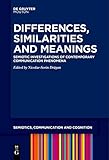Differences, Similarities and Meanings : Semiotic Investigations of Contemporary Communication Phenomena / ed. by Nicolae-Sorin Drăgan.
Material type: TextSeries: Semiotics, Communication and Cognition [SCC] ; 30Publisher: Berlin ; Boston : De Gruyter Mouton, [2021]Copyright date: ©2021Description: 1 online resource (VI, 308 p.)Content type:
TextSeries: Semiotics, Communication and Cognition [SCC] ; 30Publisher: Berlin ; Boston : De Gruyter Mouton, [2021]Copyright date: ©2021Description: 1 online resource (VI, 308 p.)Content type: - 9783110658828
- 9783110659238
- 9783110662900
- 302.2 23
- P99
- online - DeGruyter
- Issued also in print.
| Item type | Current library | Call number | URL | Status | Notes | Barcode | |
|---|---|---|---|---|---|---|---|
 eBook
eBook
|
Biblioteca "Angelicum" Pont. Univ. S.Tommaso d'Aquino Nuvola online | online - DeGruyter (Browse shelf(Opens below)) | Online access | Not for loan (Accesso limitato) | Accesso per gli utenti autorizzati / Access for authorized users | (dgr)9783110662900 |
Frontmatter -- Contents -- Introduction -- Part I: Theoretical advances -- Communication, listening, non-functionality -- Difference and similarity in the I-Other relation: between two individuals or two singularities? A semioethic approach -- Global semiotics and its developments in the direction of semioethics -- The relevance of the encyclopaedia. From semiosis to sedimentation and back again -- Cultural narrative identities and the entanglement of value systems -- Part II: Applied Semiotics -- A The digital age in semiotics and communication -- Lying as a transaction of value: explorations in semiosis and communication from a new perspective -- Effective affective campaigns? An analysis of campaigns centered on Roma -- B Political semiotics and communication -- The semiotics of extremism -- The dynamic aspect of the semiotic behavior of political actors in TV debates -- C Communication, semiotics and multimodality -- The different rifles of audiovisual communication: a semiotics of foreshadowing and the case of Roberto Benigni -- Differences, similarities and changes of national identity signs in print advertisements. The advertising discourse as a mirror of locality and vice-versa -- What’s in a nickname? Form and function of sports’ team nicknames -- Architecture and painting codes in the Annunciation. Oltenia (XVIIIth–XIXth centuries) -- Index
restricted access online access with authorization star
http://purl.org/coar/access_right/c_16ec
In a world of global communication, where each one’s life depends increasingly on signs, language and communication, understanding how we relate and opening ourselves to otherness, to differences in all their forms and aspects is becoming more and more relevant. Today, we often understand the differences in terms of adversity or opposition and forget the value of the similarities.Semiotic approaches can provide a critical point of view and a more general reflection that can redefine some aspects of the discussion about the nature of these semiotic categories, differences and similarities. The dichotomy differences – similarities is fundamental to understanding the meaning-making mechanisms in language (De Saussure, 1966; Deleuze, 1995), as well as in other sign systems (Ponzio, 1995; Sebeok & Danesi, 2000). Meaning always appears in the “play of differences” (Derrida, 1978) and similarities. Therefore, the phenomena of similarities and differences must be considered complementary (Marcus, 2011).This book addresses and offers new perspectives for analyzing and understanding sensitive topics in the world of global communication (humanities education, responsive understanding of otherness, digital culture and new media power).
Issued also in print.
Mode of access: Internet via World Wide Web.
In English.
Description based on online resource; title from PDF title page (publisher's Web site, viewed 25. Jun 2024)


